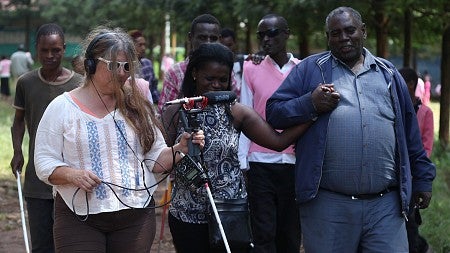Anyone who’s wondered what it’s like to live without sight could soon get a unique glimpse into the life of a woman who is blind, thanks to an immersive sound narrative developed by a UO graduate student.
In October, multimedia journalism master's student Mary Anne Funk traveled to Ethiopia to document the story of Abby Abebech Griffith, a woman now living in Portland. Griffith lost her sight at age 8 when a cobra attacked her at a river near her childhood home in Ethiopia.
“On that day, while playing with her friends, Abby tripped and fell, coming face to face with a cobra. It spit venom in her right eye,” Funk said. “Within days, Abby was completely blind in her right eye, and within a year she was blind in both eyes.”
Funk received a research travel grant from the School of Journalism and Communication to capture content for her immersive media story “Abby’s Dream Journey.” The grant also allowed her to discuss her larger ethnographic project, “Seeing Through Hearing: The Illumination of Unsighted Navigation and of Memories Based Solely on Sound,” at the African Forum on Visual Impairment in Addis Ababa, Ethiopia.
During the presentation, Funk spoke about the importance of accessibility in media and about the immersive project she and Griffith are working on. Griffith told her personal story, discussed the lack of educational materials for students who are blind in Ethiopia and addressed the stigma she experienced when she was younger.
To document Griffith’s story, Funk recorded audio of the woman’s visit with her family at her mother’s home in Areka, Ethiopia. It was the second time Griffith had been home since moving to the United States as a teenager to seek out resources to address her visual impairment. (Use headphones to listen to a one-minute immersive sound recording of Griffith’s joyful reunion with her family.)
Accompanied by multimedia journalism master’s student and videographer/photographer Lynnette Oostmeyer, Funk and Griffith also visited the school where Griffith first learned how to read Braille as well as the river where she lost her sight.
“The more we spoke about her life experiences and memories, the more I began to realize that to tell Abby’s holistic story, we had to go back to where it all began,” Funk said. “We had to go to where her visual memories take her.”
Funk first met Griffith through the woman’s boyfriend, David Bouchard, who is also blind.

A major component of Funk’s project is based on Griffith’s ability to dream visually despite her blindness. In her dreams, Griffith still sees her world as it existed more than 20 years in the past.
“It was through her visual dreams that we were inspired to go back to Ethiopia,” Funk said.
In addition to creating the immersive media story, Funk is researching how to tell compelling stories through immersive sound narratives using binaural and ambisonic microphones. She used standard microphones to record interviews and immersive audio technology to capture the sounds of Ethiopia.
Her final project will be an in-person immersive experience that includes ambient audio recordings, interviews, conversational dialogue, participant observation, visual documentation and a tactile experience exhibit with multiple listening stations. Each listening station will feature photo prints representing the audio clips visitors will hear as well as text and Braille descriptions.

Funk will present her final project as the capstone for her master’s degree in March at the School of Journalism and Communication’s Oregon Reality Lab at UO Portland. She also plans to take her finished project back to Ethiopia to share with Griffith’s family, to the Washington School for the Blind where Griffith attended middle school, and to the Ligaba Primary School in Ethiopia where Griffith learned to read Braille.
Griffith and Funk are also returning to Ethiopia in 2021 to advocate for the needs of children who are blind, and Funk is working on a collaborative art show in Portland with artists who are blind and visually impaired to showcase their artwork and “Abby’s Dream Journey.”
“All of the support from faculty in the SOJC, and this experience working on ‘Abby’s Dream Journey,’ have helped me grow as a storyteller,” Funk said. “It has helped me understand the importance of creating content that is accessible. I will never again create a story or put something online that doesn’t take that into account first.”

